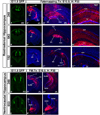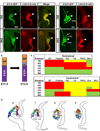Transcriptional regulation of enhancers active in protodomains of the developing cerebral cortex
- PMID: 24814534
- PMCID: PMC4104757
- DOI: 10.1016/j.neuron.2014.04.014
Transcriptional regulation of enhancers active in protodomains of the developing cerebral cortex
Abstract
Elucidating the genetic control of cerebral cortical (pallial) development is essential for understanding function, evolution, and disorders of the brain. Transcription factors (TFs) that embryonically regulate pallial regionalization are expressed in gradients, raising the question of how discrete domains are generated. We provide evidence that small enhancer elements active in protodomains integrate broad transcriptional information. CreER(T2) and GFP expression from 14 different enhancer elements in stable transgenic mice allowed us to define a comprehensive regional fate map of the pallium. We explored transcriptional mechanisms that control the activity of the enhancers using informatics, in vivo occupancy by TFs that regulate cortical patterning (CoupTFI, Pax6, and Pbx1), and analysis of enhancer activity in Pax6 mutants. Overall, the results provide insights into how broadly expressed patterning TFs regulate the activity of small enhancer elements that drive gene expression in pallial protodomains that fate map to distinct cortical regions.
Copyright © 2014 Elsevier Inc. All rights reserved.
Figures







References
-
- Armentano M, Chou SJ, Tomassy GS, Leingärtner A, O’Leary DD, Studer M. COUP-TF1 regulates the balance of cortical patterning between frontal/motor and sensory areas. Nat. Neurosci. 2007;10:1277–1286. - PubMed
-
- Bielle F, Griveau A, Narboux-Nême N, Vigneau S, Sigrist M, Arber S, Wassef M, Pierani A. Multiple origins of Cajal-Retzius cells at the borders of the developing pallium. Nat. Neurosci. 2005;8:1002–1012. - PubMed
-
- Bishop KM, Goudreau G, O’Leary DD. Regulation of area identity in the mammalian neocortex by Emx2 and Pax6. Science. 2000;288:344–349. - PubMed
Publication types
MeSH terms
Substances
Grants and funding
- R01 HG003988/HG/NHGRI NIH HHS/United States
- T32 GMO7618/PHS HHS/United States
- T32 GM007449/GM/NIGMS NIH HHS/United States
- R01NS062859A/NS/NINDS NIH HHS/United States
- F32 GM105202/GM/NIGMS NIH HHS/United States
- R01 NS099099/NS/NINDS NIH HHS/United States
- R01HG003988/HG/NHGRI NIH HHS/United States
- R01 NS062859/NS/NINDS NIH HHS/United States
- R37 MH049428/MH/NIMH NIH HHS/United States
- T32 GM007618/GM/NIGMS NIH HHS/United States
- R01NS34661/NS/NINDS NIH HHS/United States
- R01 MH094589/MH/NIMH NIH HHS/United States
- R01 NS034661/NS/NINDS NIH HHS/United States
LinkOut - more resources
Full Text Sources
Other Literature Sources
Molecular Biology Databases

